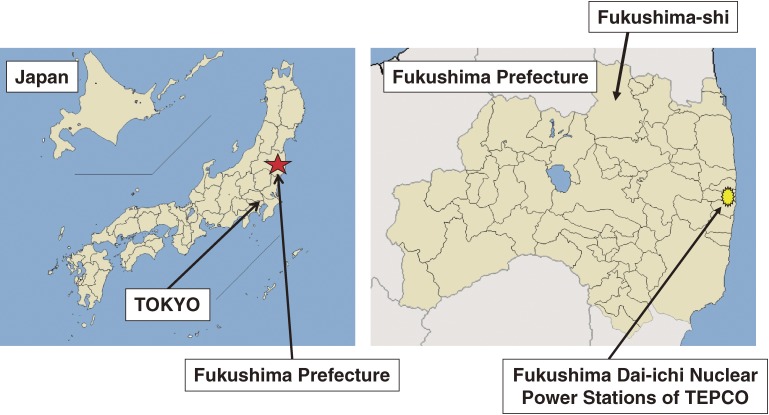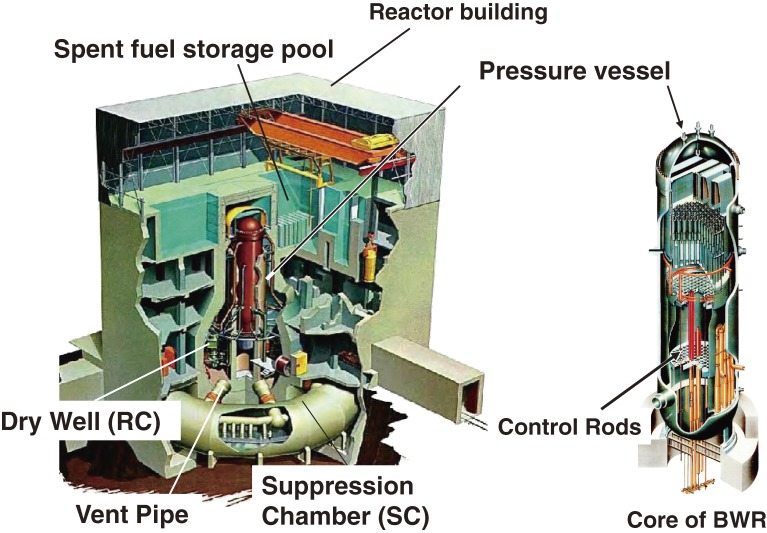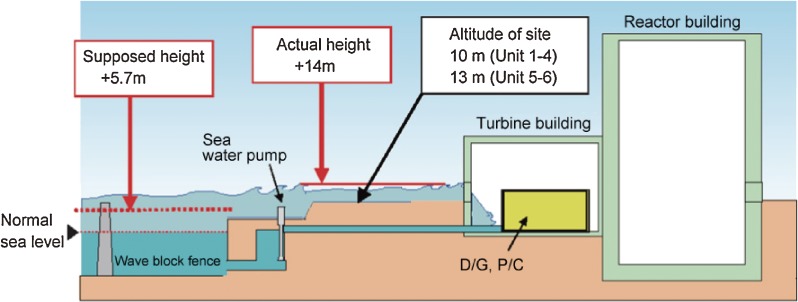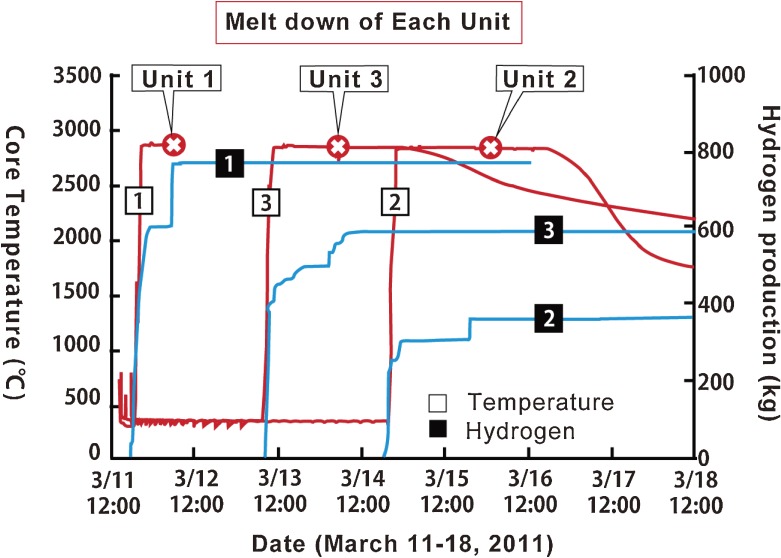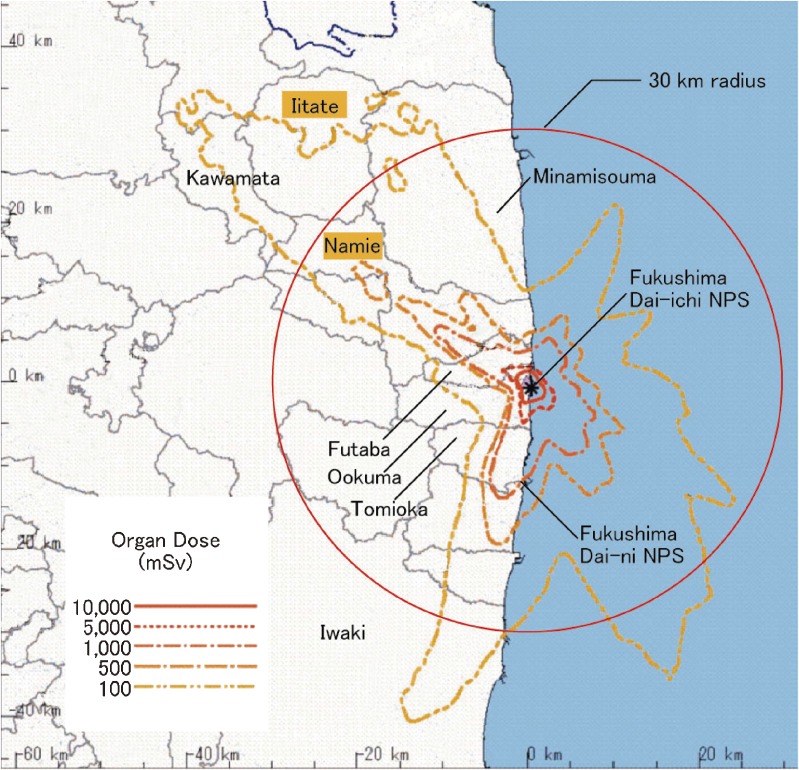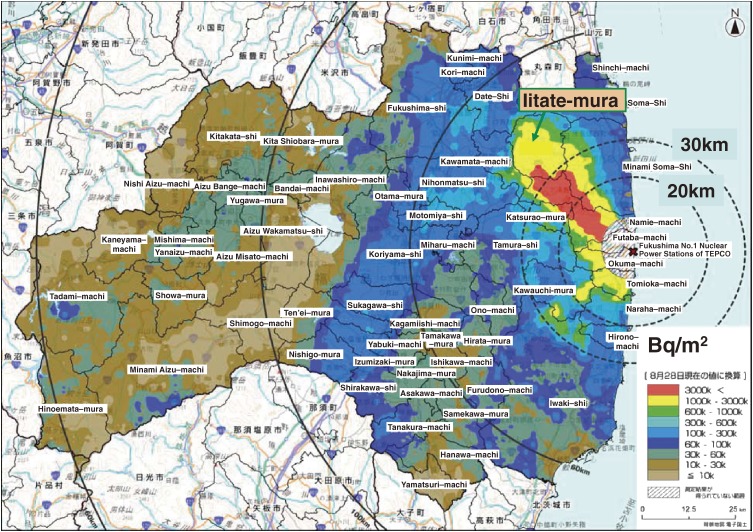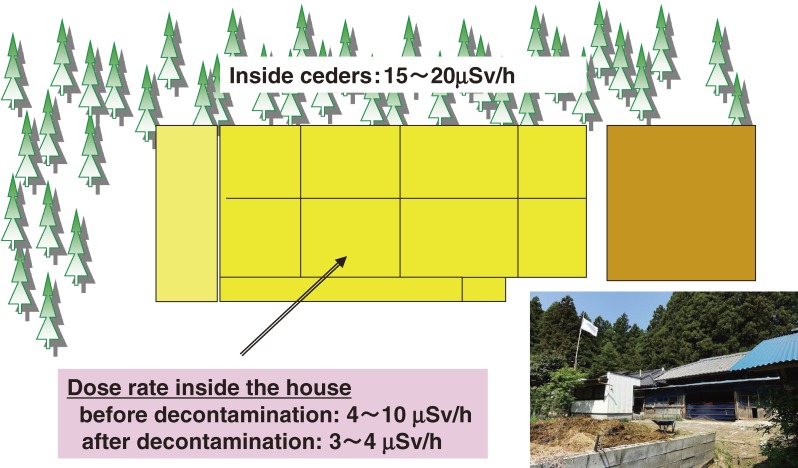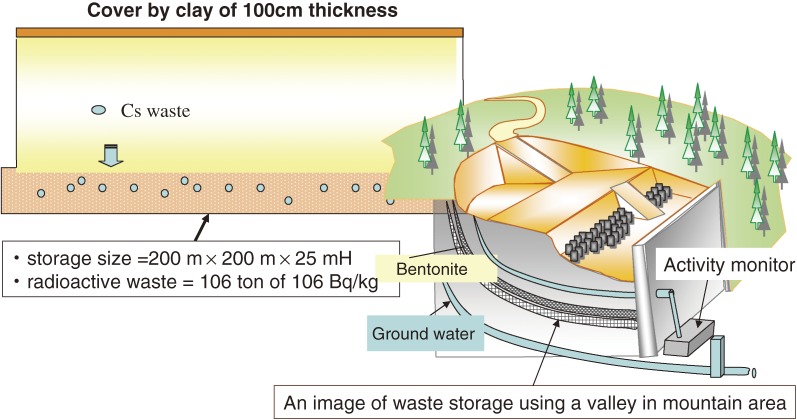Abstract
The severe accident that broke out at Fukushima Dai-ichi nuclear power stations on March 11, 2011, caused seemingly infinite damage to the daily life of residents. Serious and wide-spread contamination of the environment occurred due to radioactive materials discharged from nuclear power stations (NPSs). At the same time, many issues were highlighted concerning countermeasures to severe nuclear accidents. The accident is outlined, and lessons learned are extracted with respect to the safety of NPSs, as well as radiation protection of residents under the emergency involving the accident. The materials of the current paper are those released by governmental agencies, academic societies, interim reports of committees under the government, and others.
Keywords: Fukushima Dai-ichi NPS nuclear power accident, TEPCO, radioactive contamination, measure for resident, decontamination of environment, legal claim to damage
Introduction
The TEPCO Dai-ichi Nuclear Power Station (NPS) of Tokyo Electric Power Company (TEPCO) is located in Futaba County of Fukushima Prefecture, facing a seashore of the Pacific Ocean, as shown in Fig. 1. The East Japan Earthquake broke out at 14:46 on March 11, 2011, and the subsequent unprecedented tsunami struck the NPS at 15:27. All core cooling systems of the NPSs were lost immediately after the tsunamis, resulting in meltdowns of the fuel cores of Units 1 to 3 of the NPS; the resulting high temperature in the reactor generated a large amount of hydrogen by chemical reactions of the Zr fuel cladding and vaporized water. A couple of hydrogen explosions erupted out at Units 1 to 3, and massive amounts of radioactive materials were discharged to the environment. The reactor building of Unit 4 was also demolished by a hydrogen explosion due to hydrogen leaked in from Unit 3, exposing the spent fuel storage pool to the atmosphere.
Figure 1.
Location of Fukushima Dai-ichi Nuclear Power Stations of TEPCO. The Station faces to Pacific Ocean and is about 200 km from Tokyo.
The accident has seriously contaminated the environment, such as houses, farmland, forests and seacoasts, resulting in significant radiation exposure to residents. After one year, there seems to be no concrete program to recover from the damage to the environment and to nuclear power applications, while the nation is forced to struggle with a desperate, seemingly endless battle with radiation.
In this review, attempts are made here to overview the accident and to extract lessons learned based on released reports and data. Attempts are also made to find a way to recover daily life and environments for residents, while rectifying social and economical damage, as well.
Outline of the accident
Units 1–4 NPSs that suffered the accident were constructed at the site of Fukushima Dai-ichi NPS during 1971–1978. The total capacity of the NPS is 4,696 MW, including Units 5 and 6, which were installed before 1979. Units 1 to 3 were operating normally, and Unit 4 was under regular maintenance at the time of the earthquake and the tsunami attack. Units 5 and 6 were under regular maintenance, and both units were declared “cold shutdown” on March 20 using an air-cooled diesel power supply that survived after the tsunami. The specifications of the NPSs are summarized in Table 1.
Table 1.
TEPCO Fukushima Dai-ichi Nuclear Power Station and the power generating capacities of the units (kilowatts)
| Unit 1 | Unit 2 | Unit 3 | Unit 4 | Unit 5 | Unit 6 | |
|---|---|---|---|---|---|---|
| Electric output (10,000 kW) | 46.0 | 78.4 | 78.4 | 78.4 | 78.4 | 110.0 |
| Commissioned | 1971 | 1974 | 1976 | 1977 | 1978 | 1979 |
| Fuel assemblies | 400 | 548 | 548 | 548 | 548 | 764 |
| Number of control rods | 97 | 137 | 137 | 137 | 137 | 185 |
Figure 2 shows a typical bird-eye view of the MARK-I type reactor containment for a Boiling Water Reactor (BWR). In MARK-I, the Reactor Containment (RC) and Suppression Chamber (SC) are arranged outside of the reactor pressure vessel (RPV), where any vapor containing radioactive materials produced during accidents should be carried to RC through SC, and then released through a stack (a chimney for exhaust gas from the reactor building) to the environment. With this design, vaporized water and radioactive iodine are condensed in the water of SC and RC, arranged inside a reactor building, thus assuring the confinement of any radioactive materials in the pressure vessel. No confining system, however, worked properly during the present accident, although breakage of the RC had never been predicted in safety specifications and regulations. Besides, an unpredicted serious condition also broke out at the spent-fuel pools of Units 1–4 where no cooling water was supplied, and large amounts of spent fuels had been stored; the water was evaporated by the decay-heat. The fuels produced significant decay heat, even after the cooling system of spent fuel had terminated to supply cooling water.
Figure 2.
Typical bird-eye view of the MARK-I type reactor containment of Units 1 to 4 of Fukushima Dai-ichi Nuclear Power Station. Left figure is taken after modification from the report of March 19, 2011 by the Nuclear Energy Institute of the United States, courtesy of GE corporation.
The most important issue concerning the safety of NPSs is to block the discharge of any radioactive materials into the environment. This is attained by promptly stopping chain reactions during any emergency, with continuous cooling of the decay heat of fuels, and confining all radioactive materials. In the present accident, the chain reaction of all NPSs stopped automatically at the start of the strong earthquake. However, the tsunamis destroyed all external and internal power supplies, and the heat-sink system using sea water, leading to the loss of all cooling functions of Units 1 to 4, as shown in Fig. 3.
Figure 3.
Electric power of Emergency Diesel Generators (D/G) and power supply of Power Center (P/C) compared to the tsunamis of about 14 m height. Taken after modification from the original figure provided by TEPCO.
After the shutdown of fission reactions, decay heat is emitted from the fission products (FP’s) in spent fuels for a substantial time. This decay heat amounts to approximately 5 to 7% of the thermal power of the involved NPS immediately after shut-down, decreases to 0.3 to 0.5% after one-day, about 0.2% even after 10 days. For example, the decay heat of Unit 1 is about 5 MW after 3 days, when operated at about 200 megawatt thermal (MWt), corresponding to about 60 megawatt electricity (MWe). Continuous cooling of the decay heat, therefore, is essential after the shutdown of a reactor for more than 3 years before natural cooling becomes sufficient to cope with the heat. The cooling systems of Units 1 to 4, however, became non-functional one after another within a couple of days.
The temperature of the fuel is thought to rise immediately up to about 1200 ℃ without cooling, at which point an exothermic reaction of Zi-alloy fuel cladding with high-temperature steam produces massive quantities of hydrogen. When the fuel temperature reaches to about 2400–2500 ℃, the ceramic fuels melt and release fission products. These events took place during the present accident. Vaporized radioactive materials were discharged along with hydrogen and steam from the pressure vessel into RC through SC. Further, the seal of RC was broken, since the temperature and pressure of gases were much higher than the designed values. Hydrogen that leaked into the reactor buildings exploded: at 15:36 on March 12 in Unit 1, at 11:01 on March 14 in Unit 3, and at 6:00 on March 15 in Unit 4. Besides, an explosion around SC occurred at aound 6:00 on March 15. Figure 4 shows the change of the core temperature and hydrogen production in Units 1, 2, and 3. The reactor buildings were demolished. As a result, large amounts of gaseous radioactive materials were discharged into the atmosphere from March 12 to 16, and significant leakage continued until around the end of March.
Figure 4.
Core temperature and hydrogen production in Units 1 to 3 (from TEPCO data). Taken from Mainichi Newspaper after modification and permission.
At the beginning, the core cooling systems, even without using AC power, had worked and supplied cooling water into the reactor pressure vessel: the isolation condenser (IC) in Unit 1, the reactor core cooling system (RCIC) in Unit 2, and the RCIC and high pressure injection system (HPCI) in Unit 3. The system, however, eventually stopped by exhausting all operating power due to incorrect decisions by the operators. No water was subsequently supplied for a certain period before either sea water or freshwater was injected with the use of fire-engine pumps through fire-extinguishing lines. Later, circulation cooling systems were established to continuously feed freshwater into the RPV of Units 1 to 3. Cooling water for the spent fuel pools was supplied using concrete pump trucks.
The Japanese government declared last December that all NPSs in Fukushima Dai-ichi site had become stabilized to a temperature of less than 100 ℃, and that the discharge of radioactive materials had almost stopped.1–5)
Emergency response to residents
At 16:45 on March 11, TEPCO notified the government that an emergency had occurred based on the Special Law of Emergency Preparedness for Nuclear Disaster. At that time, all AC power had been lost, and the emergency core cooling of Units 1 and 2 didn’t work, as well. Upon notification, the Prime Minister declared a nuclear emergency at 19:03, and established the Nuclear Emergency Response Headquarters (NERHs) and the Local Nuclear Emergency Response Headquarters.
At 21:23 of March 11, the Prime Minister ordered all residents within a 3 km distance to evacuate, and also all people within 3–10 km distance from the NPS to stay in their homes. Furthermore, the evacuation area was expanded to a 20 km radius at 18:25, March 12, and the stay in-house area to a 30 km radius at 11:00, March 15. A series of instructions had been released based only on speculation that an enormous cloud of radioactive materials may be discharged, though no rational information concerning the distribution of radioactive materials had ever been given.1,2)
Any emergency response to residents must be instructed by the Headquarters based on the Special Law of Emergency Preparedness for Nuclear Disaster, which advises on matters concerning the evacuation of residents when an external effective dose above 50 mSv and/or an equivalent dose to the infant thyroid gland from radioactive iodine above 500 mSv would be predicted. For predicting the diffusion of radioactive materials, a Simulation System for Prediction of Environmental Emergency Dose Information (SPEEDI) was in operation,6) but the information of SPEEDI had never been used at the initial stage, although the dose distribution over a wide area had been predicted using weather forecasts at every hour from March 11. Consequently, no helpful data was used for proper evacuation, while the order to evacuate as soon as possible ran among the residents mainly through TV. Unfortunately, the residents without proper information had to stay at higher-dose areas in the midst of confusion after March 15. In addition, many hospitalized patients and elderly people were sacrificed because of insufficient support during the urgent evacuation. Whole-body counters available at a medical center of the city of Fukushima were never used on children at the most essential time, and only an estimation to thyroid with SPEEDI, shown in Fig. 5, was released on March 23. On July 11, a group of the National Instituite of Radiological Sciences (NIRS) announced the estimated organ dose to thyroid for 1080 children based on simple radiation measurements carried out at the end of March, 2011. The estimation was 42 mSv at the maximum and 12 mSv, which was smaller than the prediction by SPEEDI. The reason for the difference has never been clarified, but it is supposed that radioactive iodine was not significantly in air, since it fell immediately down to the ground along with heavy snow and rain.
Figure 5.
Exposure to the thyroid estimated with SPEEDI code, released on the end of March 2011. Dose represents an integral one from 6:00 a.m. of March 12 to 0:00 a.m. of March 24. Taken after modification from the former Safety Commission of Japan.
Almost one month after the accident, on April 22, considering a possibility of further discharges of radioactive materials, the evacuation area within a 20 km radius was set by the Headquarters as a deliberate evacuation area where the entry of the people was restricted. Besides, a prepared evacuation area, where residents could stay in their houses, was instructed to be between 20 km to 30 km radius for any future emergency. At the same time, environment monitoring demonstrated that municipalities of Iitate-mura and Kawamata-machi outside of the 20 km radius were heavily contaminated, such that the predicted dose of the residents exceeded 20 mSv per year. Thus, the areas were established as the deliberate evacuation areas, and people were recommended to evacuate for within almost one month so as to minimize additional exposure. Almost all residents had evacuated before the end of May, but some had decided to remain. As a consequence, areas within Fukushima prefecture were categorized into three zones based on the dose ranges of ICRP recommendation:
-
•
Emergency exposure situation: zone more than 20 mSv per year,
-
•
Existing exposure situation: zone from 1 to 20 mSv per year,
-
•
Planned exposure situation: zone less than 1 mSv per year.
Because the government and the media at that time had repeated such an explanation that exposure of less than 100 mSv would not promptly affect the health of people, and no evacuation would be needed at this time, this instruction of evacuation by the government caused ineradicable distrust and anxiety among the residents.
Counter measures to radioactive materials in the environment
1. Radioactive materials discharged to the environment.
The main radioactive materials discharged into the atmosphere were 131I, 133I, 134Cs, 137Cs, and rare gases (133Xe, 85Kr). The total amount estimated by the Nuclear Safety Commission (NSC) on April 12 was 1.5 × 1017 Bq for 131I, 1.2 × 1016 Bq for 137Cs, and also 6.3 × 1017 Bq in iodine equivalent. Based on these values, the level of the accident was recognized as 7 of the International Nuclear Event Scale (INES). Nuclear and Industry Safety Agency (NISA) and the NERHs initially assessed the present accident to be at level 3 of INES, and changed the assessment, as shown in Table 2, although the melt-down of the core was recognized even at the beginning of the accident. The total amount in iodine equivalent was corrected to 7.7 × 1017 Bq on June 6 and 4.8 × 1017 Bq on Feb. 16, 2012 by NISA, and 9.0 × 1017 Bq by TEPCO on May 24, 2012, as well. TEPCO estimated the radioactivity discharged from each Unit to be 1.3 × 1017 Bq for Unit 1, 3.6 × 1017 Bq for Unit 2, 3.2 × 1017 Bq for Unit 3, and 1.1 × 1017 Bq for not specified, which were thought to be mainly discharged into the atmosphere from March 15 to 16.
Table 2.
Transition of International Nuclear Event Scale assessed by NISA
| Date | Assessment |
|---|---|
| March 12, 0:30 | level 3 for loss of coolant in all reactors |
| March 12, evening | level 4 for high level of the radiation monitor |
| March 18 | level 5 to Unit 1, Unit 2, and Unit 3, and level 3 to Unit 4 reactor, for a high possibility of fuel damage |
| April 4 | level 7 |
Large amounts of radioactive materials were discharged from Unit 2 during the morning of March 15. Gaseous radioactive materials had diffused to the northwest of the NPS with wind, and unfortunately precipitated onto the ground with heavy snow and rain at around the midnight of March 15 to the early morning of March 16, causing serious contamination. The discharge of radioactive materials had continued more or less from March 12 to the end of the month, contaminating a wider area in Fukushima Prefecture and adjacent prefectures. Yasunari et al.7) estimated 137Cs contamination across Japan using a model calculation, and a surface contamination map based on measurements by airplane, as presented by the Ministry of Education, Culture, Sport, Science and Technology (MEXT); shown in Fig. 6.8)
Figure 6.
Contamination by 134Cs and 137Cs in Fukushima Prefecture measured using an airplane on April 20, 2011. Taken after modification from MEXT’s Website to Enlarge Distribution Maps of Radiation Doses, etc./Digital Japan Web System.
The dominant nuclide contaminating the environment in the beginning was 131I, with a half-life of 8 days; and after May in 2011 134Cs and 137Cs, having a half life of about 2 and 30 years, respectively, became dominant.
2. Decontamination and radioactive waste.
The decontamination of 134Cs and 137Cs is essential for reducing the radiation level to less than 20 mSv per year, so that evacuated residents would be able to return to their life and work in their hometowns. 134Cs and 137Cs have remained near to the surfaces of the ground, houses, forests, roads, rice fields, and fruit trees, etc. Therefore, decontamination can only be efficiently achieved by removing 134Cs and 137Cs.
On August 26, 2011, a special law was established for the decontamination of radioactive materials in the environment, in which an idea was proposed to minimize the area above 20 mSv/y step by step, and as soon as possible. According to this idea, the following policy was presented concerning decontamination by the Cabinet Office on September:
-
For any special decontamination areas greater than 20 mSv per year
-
•
to minimize step by step the area as soon as possible.
-
•
to tackle with a long-term plan any area heavily contaminated space.
-
•
-
For decontamination areas smaller than 20 mSv per year
-
•
to aim for exposure of less than 1 mSv per year as a long-term target.
-
•
to reduce exposure to the public by 50% by August 2013, compared with that at August 2011.
-
•
to reduce the exposure to children by 60% by August 2013 compared with that at August 2011, by decontaminating schools and parks with priority.
-
•
Besides, it is also suggested that the government has a responsibility for decontamination of the former area, while each municipality has a responsibility for decontaminating the later-mentioned area. In addition, all costs should be born by TEPCO.
For any area where the residents have been forced to evacuate, the government proposed a new measure of decontamination based on the dose rate as of last December, as follows:
-
1)
any area with radiation less than 20 mSv per year must be decontaminated before mid 2012,
-
2)
any area with radiation from 20 to 50 mSv per year must be decontaminated within a few years, and
-
3)
any area with radiation higher than 50 mSv per year needs more than 5 years to lift the evacuation.
These measures produced serious confusion and dismay among the residents and communities especially for those categorized as 2) and 3), because it was proposed without any practical procedure or practice concerning decontamination or any detailed explanations to the residents. Subsequently, the residents lost even a tiny hope for being able to return to their home town within a short time.
3. Example of decontamination.
On May, 2011, Radiation Safety Forum, a NPO and several companies voluntarily tried to study a possibility of decontamination in advance of the government measures, and worked on a typical farm house of Iitate-mura, where all of the residents were forced to evacuate before the end of May. Significant contamination by radioactive cesium was observed everywhere in the vicinity of the farm houses, as shown in Fig. 7 ; high ambient dose rates ranged from 13 to 15 µSv/h, and the maximum dose rate was 170 µSv/h at some parts of waterspouts. The dose rates inside the house were about 4 to 10 µSv/h before decontamination, and 3 to 4 µSv/h afterwards; these values were higher than our expectations after decontamination. Later, a simulation employing a Monte-Carlo Radiation Transport Code (PHITS9)) made it clear that the unexpectedly high dose rates in houses was due largely to cedar trees in the backyards, as shown in Fig. 8. It was suggested that decontamination had to be done broadly for all matter within about 30 to 50 m distance from each house, depending on the surrounding condition. Other decontamination procedures for rice fields, vegetable fields, and meadows were also tried, and it was confirmed that about 80% to 90% of radioactive cesium can be removed by stripping soil and grass roots with 2–3 cm thickness.
Figure 7.
Typical farmer house contaminated by 134Cs and 137Cs in IItate-mura of Fukushima Prefecture (on May 19, 2011).
Figure 8.
Dose rate inside the house before and after decontamination around the house. A PHITS simulation indicated dose contribution of about 3∼4 µSv/h after decontamination inside the house due to radiations from cedars.
4. Disposal of radioactive waste.
Decontamination accompanies a huge amount of radioactive waste. The total amount in Fukushima Prefecture is roughly estimated to be over 3 × 107 m3, which is composed of soil, ballast, concrete, grass, wood, metal, and dung. Since the radioactivity of 134Cs and 137Cs is over 106 Bq/kg at maximum, it must be managed safely for a few hundred years, considering the half-life of 137Cs. The Ministry of the Environment has proposed an idea to the residents in Fukushima Prefecture with respect to waste management. Namely, waste is tentatively stored near any decontaminated site for 3 years; after that, all waste is to be collected and transferred to a couple of interim storage facilities for storage of about 30 years; finally, it is to be disposed outside of Fukushima Prefecture. Three interim storages are expected to be made in municipalities close to Fukushima Dai-ichi NPS, but no agreement had been reached among the residents and municipalities as of June 2012.
Thus, the government now confronts a tough opposition of residents concerning the disposal sites. Generally, it is not easy to reach agreements with residents concerning waste disposal sites, even though any decontamination of the environment is impossible without them. Most residents eventually figured out that waste disposal sites are necessary for decontamination. At the same time, they wouldn’t accept any waste from other municipalities. In addition, it is rather risky to convey huge amounts of waste from tentative sites to interim storage sites by passing through winding mountain roads. In this context, waste management will be a very difficult issue in the future.
The most important issue for safety concerning the disposal of radioactive waste is to avoid leaking any radioactive materials from the disposal facility, and to adequately reduce radiation in the surrounding area. The cesium atom has such a characteristic as to be strongly trapped inside a kind of clay, and is never released easily. For example, Fig. 9 shows a simulation concerning the safety of a waste facility, in which radioactive waste of 106 m3 with a density of 106 Bq/kg has been stored in a space of 200 m in width, 200 m in length, and 25 m in depth. At the bottom, a kind of clay, bentonite for fixing radioactive Cs, is arranged to prevent the leakage of cesium, because the mobility of Cs is about 3 mm for 300 years in bentonite clay. On the other hand, radiations are shielded by covering the waste with soil of 100 cm thickness, by which the surface dose is estimated to be less than 10−3 µSv/h at the center of the facility. For further confirmation of the safety, it is also recommended that the radioactivity be continuously monitored for leaked water as well as any radiation from the facility.
Figure 9.
Assessment of the safety design for waste storage and an image of storage, of which surface dose on clay cover is <10−3 µSv/hr (1/10 of background dose rate) and mobility of Cs in Bentonite is about 0.3 mm per 300 years.
Based on the above simulation, it is stressed that decontamination waste can be safely and easily managed in each municipality, and it is recommend to change the governmental measures concerning waste management, so that the decontamination process can be started.
5. Confusion about radiation protection criteria.
After the accident, the criteria for radiation protection have often been changed by governmental agencies without considering various exceptional situations of the aftermath of an accident. Questionable criteria and messages can be depicted as follows:
-
•
to change the criteria for the evacuation from 50 mSv to 20 mSv after an accident without any acceptable explanation to people.
-
•
to repeat a message that a smaller exposure is better and that 1 mSv per year is desired, while many people are forced to live under an existing exposure situation of 1 to 20 mSv per year.
-
•
to change the target of the dose limit suddenly for children in school from 20 mSv/y to 1 mSv/y under strong voices of parents and teachers who are against the same dose limit for children as that for adults.
-
•
to instruct 50 Bq/kg as a regulation criterion for seawater bathing in the summer of 2011, while setting a criterion of 200 Bq/kg for drinking water, although the food criterion of drinking water was reduced to 10 Bq/kg since April 1, 2012.
-
•
to instruct 100 mSv in a person’s life time only for internal exposure without any commitment for external exposure. Dose limits thus instructed were based on the total amount of internal and external doses, while there has been no concept of a life-time dose limit in global society so far. Besides, the instructions have never considered that many residents, at present, live under an existing exposure situation of less than 20 mSv/y, but where the dose may build up above 100 mSv.
-
•
to drastically reduce the regulatory criteria for foods and drinks, as given in Table 3 .10) While the provisional criteria were similar to those of EU, the new values can be said to be extraordinary small. Even under the existing provisional criteria, the estimated dose by the Ministry of Health, Labour and Welfare (MHLW) of the public for the internal exposure by food intake was calculated to be less than 0.1 mSv/y on the average. With the introduction of new criteria and the removal of foods exceeding the new criteria from the market, only a trivial reduction of 8 µSv/y is expected, while the shipment of agricultural foods and fishes has been greatly damaged by the new criteria.
-
•
to instruct a dose limit of 1 mSv/y for volunteer workers and 2 mSv/y on the belly of a possible pregnant female worker involving decontamination in any area of existing exposure situation. In contrast to these instructions, the residents have been instructed to continue their life in areas of existing exposure situation of less than 20 mSv/y. Therefore, the instruction not only disturbs volunteer work, it also contradicts with the living condition of inhabitants under existing exposure situations.
-
•
to instruct an unrealistic criterion smaller than 60 Bq/kg as the level of cesium activity for drainage after washing cars while 200 Bq/kg was instructed for drinking water in 2011. In addition the environment has been contaminated with much higher levels of a couple thousand Bq/kg.
It seems that some governmental agencies do not realize that unrealistic criteria and instructions not only cause serious confusion, distress and distrust among residents, but also cause difficulties in the daily life of people and in the restoration of the environment in Fukushima Prefecture. The residents of Fukushima Prefecture have to feel further stress concerning foods and health in their daily life under the reduced criteria. One of the important duties of the government is to present reasonable measures so that residents can eat, play and work as comfortably as possible by managing their concern about radiation.
Table 3.
Criteria for foods and drink in Japan
| [Bq/kg] | Old | New | EU |
|---|---|---|---|
| Drink water | 200 | 10 | 1000 |
| Milk | 200 | 50 | 1000 |
| Vegetable, Rice, Meat, Fish, Others | 500 | 100 | 1250 |
Existing criteria for foods and drinks were greatly reduced on April 1, 2012 by the government, where an internal exposure of 1 mSv per year is targeted instead of that of 5 mSv. A governmental office has estimated that internal exposure due to intake after the accident of March 11, 2011 was less than 0.1 mSv per year.
One job of governmental agencies is never to instruct the most severe and unreasonable criteria for managing exceptional circumstances after an accident. It is desired that the government will prepare consistent and realistic criteria for radiation protection, while also considering social and economic effects to overcome the accident.
Social and economical effects of the accident
1. Legal claim for damage due to a nuclear accident.
In Japan, the legal claim law requires that nuclear companies have unlimited responsibility for legal claims relevant to any nuclear accident. Electric power companies have prepared an insurance policy of 120B¥, (about 1.5B$) for each NPS to cover legal claims. On the other hand, the government is required to make compensations when the claim is over the value covered by the insurance.
In the present accident, the insurance of 120B¥ was utterly insufficient, since the damage has been comprehensive with respect to the lives of residents, damage to agriculture and fisheries, recovery of the environment, measures for radiation risk of radiation monitoring, and societal stigma etc. In order to minimize problems concerning legal claims, a committee has been established to present guidelines for the government. A couple of guidelines11) have already been presented for various kinds of claims on April 28, May 31, August 5, 2011, and March 16, 2012 so far. These cover claims related to the following types of damage:
-
•
evacuation of residents instructed by the government,
-
•
limitation of ships & planes passing through a banned area,
-
•
restrictions on the shipping of agricultural products and fishes,
-
•
limitation of products instructed by the government and public sectors as municipalities and various unions,
-
•
damage to goods and sightseeing caused by rumors concerning radiation,
-
•
indirect damage of businesses caused by the disorganization of social and industrial communities,
-
•
compensation for people exposed to radiation,
-
•
compensation for people who escaped by their self-judgment with a concern of radiation risk,
-
•
damage to the properties of public institutions,
-
•
actions carried out for residents by municipalities,
-
•
compensation for life and properties of people obligated to evacuate for a long period.
In the guidelines, extensive common issues are expected to be covered, except for individual life and health. The cost for all legal claims is estimated to be over a few trillion yen, which seems too large to be compensated by only TEPCO. Social effects cannot be covered only by money, and indirect economic damage due to the nuclear accident is of concern to cause serious difficulty to the economy of Japan.
The government must be cautious that irrational criteria concerning the radiation protection mentioned above is a big barrier to the people in Fukushima restoring agriculture and fisheries, and greatly increase the legal claims and costs. Radiation protection has to be implemented with a reasonable balance between radiation risk and damage to society.
Lessons learned
The nuclear accident at Fukushima Dai-ichi NPS provides the most serious experiences in a society using nuclear energy, which can be compared to the Chernobyl accident. Any lessons learned from the accident are important so as to prevent nuclear accidents from occurring in Japan and elsewhere in the world, as well. Comprehensive investigations and detailed discussions, therefore, are essential, but have not yet been completed by the authorized committees under the government and the diet.
I would thus like to personally address a couple of important lessons learned with respect to the regulation and regulatory systems for NPSs, measure for residents in nuclear emergency, and the competence of human and engineering resources.
1. Regulation and regulatory system.
The trigger of the accident was an enormous earthquake and tsunami, which caused all of the essential power supplies to be lost. In all safety review guides available in Japan, it has been assumed that all power supplies should never be lost for a long time, because both commercial power supplies and emergency power supplies were supposed to be restored within a couple of hours. Moreover, the probability of a severe accident has been supposed to be negligible for plural kinds of preparedness to prevent any extension of an abnormal phenomenon at each stage of the design, construction and operation of NPSs. This idea concerning severe accidents has invited such a misunderstanding that the accident management (AM) is asked to only minimize an extension of a severe accident. Consequently, AM measures have never been obligated in legal requirements, and have depended only on voluntary efforts by nuclear power companies.
The present accident made clear the failure of regulation and design concerning the multiplicity, diversity, and independency of emergency power supplies, and that effective measures against severe accidents have never been prepared in the design and safety guidelines. In addition, the disorder disclosed a weak point of regulatory systems in Japan, for which safety guidelines have been provided by the NSC, while its application for NPSs has been controlled by the NISA. The double regulation system was unique globally, but these two regulatory bodies have never worked effectively with mutual cooperation under a serious accident.
One of the lessons learned is the need to establish a unique, reliable regulatory body that is independent of politics and nuclear power companies, and having comprehensive expertise with respect to NPSs, nuclear facilities, and radiation protection. Another lesson learned is that all reviews have to be thoroughly carried out concerning safety regulation and design to protect against severe accidents.
Besides, an important philosophy should be introduced in any new regulatory guide to back fit the latest knowledge and design expertise to existing NPSs, especially concerning important safety issues.
2. Emergency preparedness and response of local municipalities and residents in an emergency.
One of the most serious issues was that no proper instructions have ever been made to local municipalities and residents by the NERHs, which was composed of government personnel, local governments, administrations, NSC and relevant research organizations. In the Special Law of Emergency Preparedness for Nuclear Disaster, an Off-site Emergency Response Center close to the NPS of interest must be established immediately, and must support emergency measures at both the site of an emergency and local municipalities, in cooperation with the NERHs. However, the off-site center did not work, because its building was not properly equipped in terms of radiation protection. No information about radiation levels in the environment had ever been supplied to local municipalities by the off-site center and the NERHs. The NERHs excuse was that radiation measurement facilities outside NPS and communication tools were damaged by the earthquake. However, NERHs had already observed higher radiation doses in the environment using mobile monitoring within a few days. Besides, the prediction of radioactive clouds by SPEEDI based on weather forecasts was never delivered to local municipalities and residents to help the evacuation, while only quick evacuations were instructed by the head of the NERHs. A few municipalities recognized the instruction to evacuate only on TV, and those residents with no information were forced to escape voluntarily into the northwest area in a state of chaos, where radiation doses were rather high, resulting in unnecessary radiation exposures to the residents. When the Prime Minister instructs evacuation to residents, the NSC is required to support it based on information of SPEEDI and others by the Special Law of Emergency Preparedness for Nuclear Disaster. However, the NSC has never delivered any information for helping the evacuation, ignoring the results of SPEEDI.
The reason should be made very clear as to how and why appropriate information wasn’t delivered, and everyone must learn from this failure. It is not profitable to make an excuse that damage by the earthquake made it impossible to use communication tools.
We must reconsider the preparedness of the residents in any nuclear emergency based on the fact that many of them may be forced to evacuate for more than 5 years and/or will be exposed to radiation in their daily life for a long time.
3. Competency of human resources and engineering.
Japan has been a major country of NPSs in the world, but the present accident clarified a lack of expertise and fundamental technology related to light-water reactors. The staff in charge of activities for managing an emergency should be familiar with every possible condition of NPSs under an emergency. The accident disclosed a shortage of expertise among staff members who had been mainly trained for only normal operation. NPSs in Japan have been imported from U.S.A., and a slogan has been repeated among the nuclear society from the mid 1970’s, because the safety of light-water reactors has been thought to have already been proven and a huge potential risk has never actually been considered seriously. As a result, national resources have been allocated to develop fast-breeder reactors and fusion reactors, while limited resources have been allocated to the research and development of light-water reactors (LWRs), although all NPSs in Japan are LWR of PWR or BWR. Also, human resources and fundamental technologies with respect to the safety of LWRs have faded away year by year, a misunderstanding by the nuclear society (called Genshiryoku Mura, meaning nuclear village), believing that nuclear technology has already been proven to be safe. This has disturbed the application of new technologies and knowledge to existing NPSs, so far.
It is impossible to restart NPS applications without appropriate and sufficient countermeasures for lessens learned and extracted from the present accident. In particular, quick and rigorous countermeasures must absolutely be implemented for severe accident management and for important safety issues. Besides, research and development must be reinforced to reduce the risk of NPSs and to foster human resources concerning LWR.
The nuclear society and stakeholders related to nuclear energy in Japan are required to mature a genuine safety culture by their best efforts.
Concluding remarks
The nuclear accident at Fukushima Dai-ichi NPSs has definitely damaged nuclear applications in Japan, and local communities. The damage is so serious that the magnitude of the impact on the society and the economy is unable to be predicted as of today. In other words, Japan and the Japanese people will be obligated to struggle with the enormous damage for a very long period. Reconstruction of the community, agriculture, fisheries, industry, and various businesses must involve very tough and long-term issues. Growing concern for low-radiation doses among people is a cumbersome issue for reestablishing any social and economic system contaminated by radioactive materials. The burden needed to recover from the accident may endanger national finances, by which Japanese may be forced to change their sense of value. We became accustomed to a material-based culture after the war.
The present accident again suggests that nuclear accidents send out shockwaves around the world, as in the cases of rather developed countries, like in the cases of the Chernobyl accident in the Soviet Union and the TMI accident in the U.S.A. One of the common issues among the accidents is caused, more or less, by the relevant humans in charge, who have enhibited self-conceit in addition to ignorance regarding science and engineering. Global communities have already recognized the risk of self-conceit, and the International Atomic Energy Agency (IAEA) has solicited the idea of developing a safety culture. In Japan, the “safety culture”, unfortunately, was only a slogan. A safety culture may produce nothing in visible benefits for companies. All stakeholders, however, must respect and foster the concept of safety culture so as not to allow serious accidents to reoccur.
I have to accept that this report is insufficient to overview the accident, and includes rather personal opinions. Besides, it is a great pleasure to me that this report will be useful for extracting lessons learned from the accident.
Four accident investigation reports are now available (not yet fully in English).12–15) There, however, seem to be an important discrepancy in understandings with respect to the causes and countermeasures of the accident among the reports. Therefore, further investigation is needed to clarify the facts in the future. Finally, I would like to ask the Japanese government to share all information with the world community regarding the accident, and lessons learned to be a common treasure for each country utilizing nuclear energy as soon as possible.
Acknowledgement
Decontamination at Iitate-mura was supported by Radiation Safety Forum, Chiyoda Technol Company, and ATOX Company. I wish to express my appreciation to Dr. Niida for a model simulation concerning the dose contribution from Japanese cedars and radiation safety analysis of waste disposal model with the PHITS code.
Profile
Shun-ichi Tanaka was born in 1945 and started his research career in 1967 with study of radiation shielding and radiation physics for nuclear energy application at Japan Atomic Energy Research Institute (JAERI), after graduating from the Department of Engineering at Tohoku University and acquired PhD at the University in 1979. He has engaged in work on radiation shielding and measurement with development of gamma-ray transport simulation for about 25 years. After that, he was appointed Director General of the Tokai Research Establishment of JAERI in 2002, and Vice President of JAERI in 2004. During the period, he was keen to promote the J-PARC project which was a joint project between KEK and JAERI. After a chair of Atomic Energy Association of Japan from 2006 to 2007, he served himself as a vice-chair of Atomic Energy Commission of Japan for 3 years. After the Fukushima Dai-ichi NP accident, he devoted himself to a volunteer work for decontaminating radioactive materials in the environment of Fukushima Prefecture for the residents. He was recently appointed to a chair of the Nuclear Regulation Authority of Japan which was newly founded on September 19, 2012.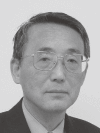
References
- 1).Investigation & Inspection Committee of the Government (2011) Interim report concerning TEPCO Fukushima Nuclear Plants. Dec. 26, 2011 (in Japanese).
- 2).Nuclear Emergency Response Headquarters Government of Japan (2011) Report of the Japanese Government to the IAEA Ministerial Conference on Nuclear Safety —The accident at TEPCO’s Fukushima Nuclear Power Stations—. June 2011. [Google Scholar]
- 3).NISA (2012) Causes and countermeasures: The accident at TEPCO’s Fukushima Nuclear Power Stations.
- 4).NISA (2012) Technical Review concerning TEPCO Fukushima Nuclear Plants. Committee of NISA —Interim Report— (in Japanese).
- 5).Hirano M., Yonomoto T., Ishigaki M., Watanabe N., Maruyama Y., Sibamoto Y., Watanabe T., Moriyama K. (2012) Insights from review and analysis of the Fukushima Dai-ichi accident. J. Nucl. Sci. Technol. 49, 1–17 [Google Scholar]
- 6).Imai, K., Chino, M., Ishikawa, H., Kai, M., Asai, K., Homma, T., Hidaka, A., Nakamura, Y., Iijima, T. and Moriuchi, S. (1985) SPEEDI: A Computer Code System for the Real-Time Prediction of Radiation Dose the Public due to an Accidental Release. JAERI, 1297.
- 7).Yasunari T.J., Stohl A., Hayano R.S., Burkhart J.F., Eckhardt S., Yasunari T. (2011) Cesium-137 deposition and contamination of Japanese soils due to Fukushima nuclear accident. Proc. Natl. Acad. Sci. U.S.A. 108, 19530–19534 [DOI] [PMC free article] [PubMed] [Google Scholar]
- 8).MEXT (2011) MEXT: Contamination & Dose Rate Monitoring by Air-Plane. http://radioactivity.mext.go.jp/old/ja/1910/2011/09/1910_0912.pdf#search=' (in Japanese).
- 9).Niita K., Sato T., Iwase H., Nose H., Nakashima H., Sihver L. (2006) PHITS—a particle and heavy ion transport code system. Radiat. Meas. 41, 1080–1090 [Google Scholar]
- 10).Department of Food Safety Pharmaceutical & Food Safety Bureau, Ministry of Health Labour and Welfare (2012) New Standard limits for radio-nuclides in foods. June 2012.
- 11).Guide-lines for legal claims relevant to damages due to the accident of the Fukushima Dai-ichi and Dai-ni Nuclear Power Plants (in Japanese).
- 12).Investigation Committee on the Accident at the Fukushima Nuclear Power Stations (2012) Final report. July 23, 2012. English summary is available at http://icanps.go.jp/eng/final-report.html
- 13).The National Diet of Japan Fukushima Nuclear Accident Independent Investigation Commission (2012) The National Diet of Japan—The official report of The Fukushima Nuclear Accident Independent Investigation Commission, submitted to the Prime Minister Noda on July 5, 2012. Executive summary is available at http://naiic.go.jp/en/
- 14).The Independent Investigation Commission on the Fukushima Nuclear Accident (2012) Research Investigation Report. Japanese version released on March 11, 2012. English version is in preparation at http://rebuildjpn.org/en/fukushima/report
- 15).TEPCO (2012) Fukushima Nuclear Accidents Investigation Report by TEPCO. June 20, 2012, http://www.tepco.co.jp/en/press/corp-com/release/2012/1205638_1870.html



